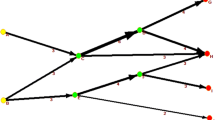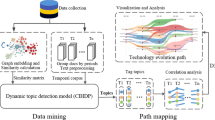Abstract
Exploring technology evolution pathways is essential since one can capture the best opportunity in a particular domain. Researchers attempt to exploit the critical trajectory from a historical perspective; however, only some steps forward to forecasting the future direction. This study proposes a new research framework to make reasonable predictions. Based on patents retrieved from DII, we construct a multiplex network consisting of co-citation and semantic layers. Specifically, we utilize the citation relationships between patents and extract technology topics with the Combined Topic Model(CTM), a powerful topic recognition tool. Subsequently, we employ the link prediction method to obtain future links and assemble them into a new co-citation network. We get credible predictions of future evolution trends by analyzing topics. To validate our framework, we take CRISPR, an emerging technology in gene editing, as a case study. Our experiments show that link prediction performs well in detecting future co-citation links, and the semantic layer further improves the prediction accuracy. We finally summarize seven potential directions and validate our predictions.
Access this chapter
Tax calculation will be finalised at checkout
Purchases are for personal use only
Similar content being viewed by others
References
Dosi, G.: Technological paradigms and technological trajectories: a suggested interpretation of the determinants and directions of technical change. Res. Policy 11(3), 147–162 (1982). https://doi.org/10.1016/0048-7333(82)90016-6
Huang, Y., et al.: A hybrid method to trace technology evolution pathways: a case study of 3D printing. Scientometrics 111(1), 185–204 (2017). https://doi.org/10.1007/s11192-017-2271-8
Huang, Y., Zhu, F., Porter, A.L., Zhang, Y., Zhu, D., Guo, Y.: Exploring technology evolution pathways to facilitate technology management: from a technology life cycle perspective. IEEE Trans. Eng. Manag. 68(5), 1347–1359 (2021). https://doi.org/10.1109/TEM.2020.2966171
Chen, L., Xu, S., Zhu, L., Zhang, J., Xu, H., Yang, G.: A semantic main path analysis method to identify multiple developmental trajectories. J. Informet. 16(2), 101281 (2022). https://doi.org/10.1016/j.joi.2022.101281
Hummon, N.P., Dereian, P.: Connectivity in a citation network: the development of DNA theory. Social Netw. 11(1), 39–63 (1989)
Batagelj, V.: Efficient algorithms for citation network analysis (2003)
Liu, H., Chen, Z., Tang, J., Zhou, Y., Liu, S.: Mapping the technology evolution path: a novel model for dynamic topic detection and tracking. Scientometrics 125(3), 2043–2090 (2020). https://doi.org/10.1007/s11192-020-03700-5
Zhang, Y., Xu, S., Yang, Y., Huang, Y.: Topic evolution analysis based on optimized combined topic model: illustrated as crispr technology. In: Sserwanga, I., et al. (eds.) Information for a Better World: Normality, Virtuality, Physicality, Inclusivity, vol. 13972, pp. 47–64. Springer, Cham (2023). https://doi.org/10.1007/978-3-031-28032-0_4
Gao, Q., Huang, X., Dong, K., Liang, Z., Wu, J.: Semantic-enhanced topic evolution analysis: a combination of the dynamic topic model and word2vec. Scientometrics 127(3), 1543–1563 (2022). https://doi.org/10.1007/s11192-022-04275-z
Huang, L., Chen, X., Zhang, Y., Wang, C., Cao, X., Liu, J.: Identification of topic evolution: network analytics with piecewise linear representation and word embedding. Scientometrics 127(9), 5353–5383 (2022). https://doi.org/10.1007/s11192-022-04273-1
Puccetti, G., Giordano, V., Spada, I., Chiarello, F., Fantoni, G.: Technology identification from patent texts: a novel named entity recognition method. Technol. Forecast. Social Change 186, 122160 (2023). https://doi.org/10.1016/j.techfore.2022.122160. https://www.sciencedirect.com/science/article/pii/S0040162522006813
Wei, T., Jiang, T., Feng, D., Xiong, J.: Exploring the evolution of core technologies in agricultural machinery: a patent-based semantic mining analysis. Electronics 12(20) (2023). https://doi.org/10.3390/electronics12204277. https://www.mdpi.com/2079-9292/12/20/4277
Hung, S.C., Liu, J.S., Lu, L.Y.Y., Tseng, Y.C.: Technological change in lithium iron phosphate battery: the key-route main path analysis. Scientometrics 100(1), 97–120 (2014). https://doi.org/10.1007/s11192-014-1276-9
Li, M., Xu, X.: Tracing technological evolution and trajectory of biomass power generation: a patent-based analysis. Environ. Sci. Pollut. Res. 30(12), 32814–32826 (2022). https://doi.org/10.1007/s11356-022-24339-0
Smojver, V., Štorga, M., Zovak, G.: Exploring knowledge flow within a technology domain by conducting a dynamic analysis of a patent co-citation network. J. Knowl. Manag. 25(2), 433–453 (2021). https://doi.org/10.1108/JKM-01-2020-0079
Lü, L., Zhou, T.: Link prediction in complex networks: a survey. Phys. A 390(6), 1150–1170 (2011). https://doi.org/10.1016/j.physa.2010.11.027
Zhou, T.: Progresses and challenges in link prediction. iScience 24(11), 103217 (2021). https://doi.org/10.1016/j.isci.2021.103217
Wang, P., Xu, B., Wu, Y., Zhou, X.: Link prediction in social networks: the state-of-the-art. Sci. China Inf. Sci. 58(1), 1–38 (2014). https://doi.org/10.1007/s11432-014-5237-y
Wu, H., Song, C., Ge, Y., Ge, T.: Link prediction on complex networks: an experimental survey. Data Sci. Eng. 7(3), 253–278 (2022). https://doi.org/10.1007/s41019-022-00188-2
Shibata, N., Kajikawa, Y., Sakata, I.: Link prediction in citation networks. J. Am. Soc. Inf. Sci. Technol. 63(1), 78–85 (2012). https://doi.org/10.1002/asi.21664
Cardillo, A., et al.: Emergence of network features from multiplexity. Sci. Rep. 3(1), 1344 (2013). https://doi.org/10.1038/srep01344
Granell, C., Gómez, S., Arenas, A.: Dynamical interplay between awareness and epidemic spreading in multiplex networks. Phys. Rev. Lett. 111(12), 128701 (2013). https://doi.org/10.1103/PhysRevLett.111.128701
Yao, Y., et al.: Link prediction via layer relevance of multiplex networks. Int. J. Mod. Phys. C 28(8), 1750101 (2017). https://doi.org/10.1142/s0129183117501017
Shan, N., Li, L., Zhang, Y., Bai, S., Chen, X.: Supervised link prediction in multiplex networks. Knowl.-Based Syst. 203, 106168 (2020). https://doi.org/10.1016/j.knosys.2020.106168
Bai, S., Zhang, Y., Li, L., Shan, N., Chen, X.: Effective link prediction in multiplex networks: a topsis method. Expert Syst. Appl. 177, 114973 (2021). https://doi.org/10.1016/j.eswa.2021.114973
Yoon, B., Kim, S., Kim, S., Seol, H.: Doc2vec-based link prediction approach using SAO structures: application to patent network. Scientometrics 127(9), 5385–5414 (2022). https://doi.org/10.1007/s11192-021-04187-4
Vital, A., Amancio, D.R.: A comparative analysis of local similarity metrics and machine learning approaches: application to link prediction in author citation networks. Scientometrics 127(10), 6011–6028 (2022). https://doi.org/10.1007/s11192-022-04484-6
Song, B., Suh, Y.: Identifying convergence fields and technologies for industrial safety: LDA-based network analysis. Technol. Forecast. Soc. Chang. 138, 115–126 (2019). https://doi.org/10.1016/j.techfore.2018.08.013
Qiu, Z., Wang, Z.: Technology forecasting based on semantic and citation analysis of patents: a case of robotics domain. IEEE Trans. Eng. Manag. 69(4), 1216–1236 (2022). https://doi.org/10.1109/TEM.2020.2978849
Liu, Y., Chen, M.: The knowledge structure and development trend in artificial intelligence based on latent feature topic model. IEEE Trans. Eng. Manag. 1–12 (2023). https://doi.org/10.1109/TEM.2022.3232178
Blei, D.M., Ng, A.Y., Jordan, M.I.: Latent Dirichlet allocation. J. Mach. Learn. Res. 3, 993–1022 (2003)
Teh, Y.W., Jordan, M.I., Beal, M.J., Blei, D.M.: Hierarchical Dirichlet processes. J. Am. Stat. Assoc. 101(476), 1566–1581 (2006). https://doi.org/10.1198/016214506000000302
Devlin, J., Chang, M.W., Lee, K., Toutanova, K.: Bert: pre-training of deep bidirectional transformers for language understanding (2019)
Bianchi, F., Terragni, S., Hovy, D.: Pre-training is a hot topic: contextualized document embeddings improve topic coherence (2021)
Srivastava, A., Sutton, C.: Autoencoding variational inference for topic models (2017)
OuYang, K., Weng, C.S.: A new comprehensive patent analysis approach for new product design in mechanical engineering. Technol. Forecast. Soc. Chang. 78(7), 1183–1199 (2011). https://doi.org/10.1016/j.techfore.2011.02.012
Filippin, F.: Do main paths reflect technological trajectories? applying main path analysis to the semiconductor manufacturing industry. Scientometrics 126(8), 6443–6477 (2021). https://doi.org/10.1007/s11192-021-04023-9
Röder, M., Both, A., Hinneburg, A.: Exploring the space of topic coherence measures. In: Proceedings of the Eighth ACM International Conference on Web Search and Data Mining, pp. 399–408. ACM, Shanghai (2015). https://doi.org/10.1145/2684822.2685324
Boccaletti, S., et al.: The structure and dynamics of multilayer networks. Phys. Rep. 544(1), 1–122 (2014). https://doi.org/10.1016/j.physrep.2014.07.001
Huang, L., Chen, X., Ni, X., Liu, J., Cao, X., Wang, C.: Tracking the dynamics of co-word networks for emerging topic identification. Technol. Forecast. Soc. Chang. 170, 120944 (2021). https://doi.org/10.1016/j.techfore.2021.120944
Ishino, Y., Shinagawa, H., Makino, K., Amemura, M., Nakata, A.: Nucleotide sequence of the iap gene, responsible for alkaline phosphatase isozyme conversion in escherichia coli, and identification of the gene product. J. Bacteriol. 169(12), 5429–5433 (1987). https://doi.org/10.1128/jb.169.12.5429-5433.1987
Mojica, F.J.M., Juez, G., Rodriguez-Valera, F.: Transcription at different salinities of haloferax mediterranei sequences adjacent to partially modified psti sites. Mol. Microbiol. 9(3), 613–621 (1993). https://doi.org/10.1111/j.1365-2958.1993.tb01721.x
Jinek, M., Chylinski, K., Fonfara, I., Hauer, M., Doudna, J.A., Charpentier, E.: A programmable dual-rna–guided dna endonuclease in adaptive bacterial immunity. Science 337(6096), 816–821 (2012). https://doi.org/10.1126/science.1225829
Cong, L.: Multiplex genome engineering using crispr/cas systems. Science 339(6121), 819–823 (2013). https://doi.org/10.1126/science.1231143
Gu, Y., et al.: Domain-specific language model pretraining for biomedical natural language processing. ACM Trans. Comput. Healthcare 3(1), 1–23 (2022). https://doi.org/10.1145/3458754
Zhang, X., Mei, L., Gao, Y., Hao, G., Song, B.: Web tools support predicting protein-nucleic acid complexes stability with affinity changes. WIREs RNA 14(5) (2023). https://doi.org/10.1002/wrna.1781
Pickar-Oliver, A., Gersbach, C.A.: The next generation of crispr-cas technologies and applications. Nat. Rev. Molecu. Cell Biol. 20(8), 490–507 (2019). https://doi.org/10.1038/s41580-019-0131-5
Li, T., et al.: Crispr/cas9 therapeutics: progress and prospects. Signal Transd. Target. Therapy 8(1) (2023). https://doi.org/10.1038/s41392-023-01309-7
Acknowledgments
We appreciate the anonymous reviewers’ careful examination of the manuscript and helpful comments. We appreciate Yihe Zhu, Yuanda Zhang, and Elysia Valentina for their help. We acknowledge support from the National Natural Science Foundation of China (Grant 72004169).
Author information
Authors and Affiliations
Corresponding author
Editor information
Editors and Affiliations
Ethics declarations
Disclosure of Interests
The authors have no competing interests to declare that are relevant to the content of this article.
Rights and permissions
Copyright information
© 2024 The Author(s), under exclusive license to Springer Nature Switzerland AG
About this paper
Cite this paper
Cheng, Z., Tang, J., Yang, J., Huang, Y. (2024). Exploring Technology Evolution Pathways Based on Link Prediction on Multiplex Network: Illustrated as CRISPR. In: Sserwanga, I., et al. Wisdom, Well-Being, Win-Win. iConference 2024. Lecture Notes in Computer Science, vol 14597. Springer, Cham. https://doi.org/10.1007/978-3-031-57860-1_8
Download citation
DOI: https://doi.org/10.1007/978-3-031-57860-1_8
Published:
Publisher Name: Springer, Cham
Print ISBN: 978-3-031-57859-5
Online ISBN: 978-3-031-57860-1
eBook Packages: Computer ScienceComputer Science (R0)




